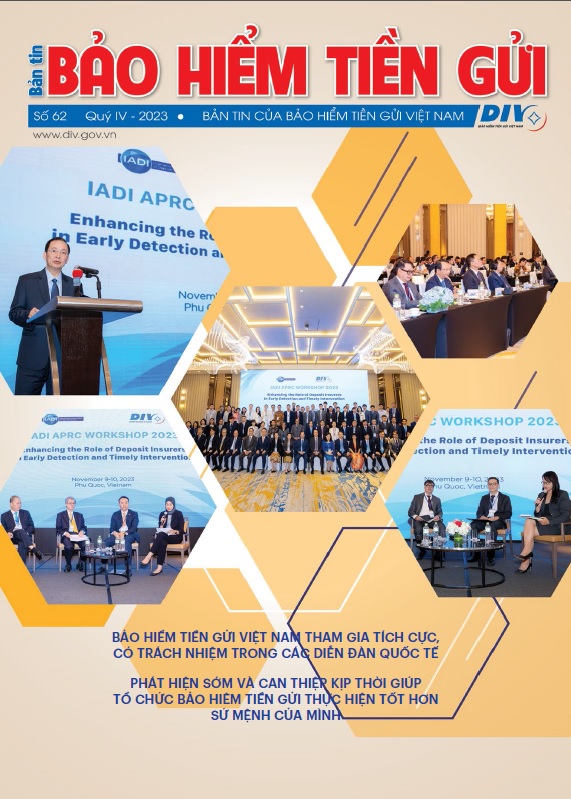Currently, the activities in the DIV system basically take place in the Internet and local network environment. Through the FSMIMS project, the deposit insurer has an overall IT system, including hardwares, softwares, general softwares, standard softwares, and professional softwares, which are centrally installed in 02 data center (DC, DRC) and deployed in the whole system of DIV. The Backup Data Center (DRC) system ensures data safety and maintains the operation of the IT system when the Data Center (DC) fails.
The new IT system of DIV fully meets the provisions of the Law on deposit insurance and is consistent with the IADI core principles for effective deposit insurance systems. These systems are fully integrated with each other and the data is shared with the warehouse of the SBV.
Namely, DIV’s IT system is built according to the following categories:
Infrastructure system: Server, Switch, Firewall, video conference system, Exadata, IDP, Backup and storage; System of standard software, system software and general software (supporting hardware operations);
Software group for logistics activities: Human Resource Management (HR); Accounting and Budgeting (ERP); Internal Audit (IA); Report and document management (DCM).
Group of software for business operations: Risk monitoring (RM); Resolution (RL); Financial Management (FM);
Information Collection and Reporting System: Information Management (IM); Intelligent management reporting system (BI): Supports building, generating, rendering, and exploiting reports of business and logistics activities.
Assessing on the basis of reference to the components in the E-Government Architecture 2.0 and the Ministry-level digital transformation indicators, in all professional activities of the DIV, there are application software that meets the requirements of daily operation. They are always studied and proposed to be modified to meet the changing regulations of the State. In addition, the DIV builds the Information Management (IM) system, which aggregates all collected data and data in other systems into a unified Data Warehouse to serve all professions.
At the same time, DIV has built a backup system at the DRC center, ensuring data safety and maintaining the operation of the main system when there are problems. In particular, DC data is daily backup, so in the event that an incident occurs, all data of the main system has been backup to the DRC system.
The IT system of DIV basically meets a number of criteria on: Cognitive conversion index; Institutional assistance index; Infrastructure index and digital platform; Information and digital data index and operating index on digital conversion.
Although the basic operations of the DIV have been transfered from manual to the network environment and many benefits have been achieved such as improving labor productivity, reducing delays in performing professional activities, etc. However, this also poses a series of challenges and risks regarding information security. If in the past, all information and data of the DIV were backed up in traditional paper documents, when the IT transformation took place, all the information of the DIV, except the confidential information, were digitized and stored on software systems. All activities of the DIV will depend entirely on technology from the Internet, network infrastructure, application software… Any large or small incidents will affect the smooth operation of the system.
The development orientation of the DIV is to gradually improve the role, functions, innovate operations, become an effective policy tool contributing to maintaining the safe and healthy development of the credit institution system in Viet Nam. Along with that, the deposit insurer has determined the overall goal for the period up to 2025, with a vision to 2030 as “Protecting the legitimate rights and interests of depositors, actively contributing to maintaining the stability of the system of credit institutions, ensuring the safe and healthy development of banking activities…”.
To be consistent with the development orientation as well as to perform the assigned political functions and tasks; on the basis of reference and experience in implementation at a number of units, the development of a digital transformation roadmap should follow closely the following contents:
Firstly, develop and promulgate an overall architectural framework towards digital deposit insurance in accordance with the E-Government Architecture Framework 2.0 promulgated in Decision 2323.
Secondly, develop and issue a set of indicators to assess the level of digital transformation of the DIV on the basis of reference to the Ministry-level digital transformation assessment index set issued in Decision 1726.
Thirdly, implement the building and promulgation of the Digital Transformation Project of the DIV in 2025, with a vision to 2030.
It can be said that building a digital transformation roadmap is indispensable when implementing digital transformation. A detailed, specific and appropriate roadmap will help the DIV to choose effective implementation methods to minimize time, effort and budget for implementation, as well as identify risks to build the optimal route, ensure the conformity with the plan and the strategic goals and orientations set out initially. Therefore, in order to build such a digital transformation roadmap, it is necessary to mobilize internal resources as well as advice from external units to ensure quality and time with output results. In that process, ensuring safety throughout the IT system is a cross-cutting, inseparable task which determines success.
In general, ensuring the security of the IT system and building a roadmap for digital transformation is an increasingly important task of the DIV. It is the responsibility of the DIV to carry out these tasks quickly to meet the expectations and challenges of today's digital age.



























